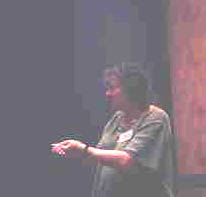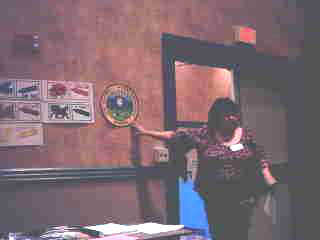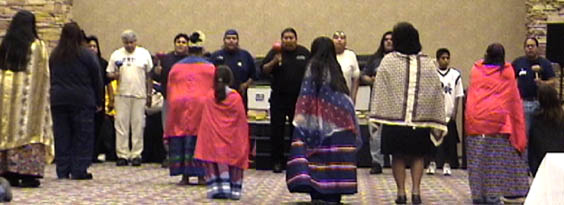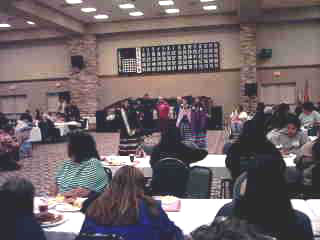2nd Annual Yuman
Language Family Summit Conference Review
Colorado River Indian Tribe - Parker, Arizona 2003
By Roy Cook
Auka! Thursday
the 16th, begings with a Blessing by Larry Gates Sr., CRIT Mohave. The
opening speech is provided by Kelly Washington, Maricopa. Lucille Watahomigie
was the guest speaker: Lucille talked about the origin of the Yuman Language
Family Summit: the challenges and accomplishments that has preceded this
second annual Pai conferance. Larry Gates Sr., CRIT Mojave then presented
a brief Origin of Mojave account from Epic times and a traditional oration
of the Mojave Tribal history from his point of view.
Contact Person for General Assembly Presentations: Lucille Watahomigie,
Hualapai Language Advocate
Phone #: 928-769-2289
e-mail: ljwata@frontiernet.net

![]() Each
of the Tribal Presentations present a greeting in their particular dialect
of the Yuman language and a brief desription of the area that their tribe
lives and how many there are of them.
Each
of the Tribal Presentations present a greeting in their particular dialect
of the Yuman language and a brief desription of the area that their tribe
lives and how many there are of them.
Colorado River Indian Tribes:
CRIT Mojave - Viola Stone
Ft. Mojave - Betty Barackman
Hualapai - Rory Majente
Havasupai - Jim Uqualla
Yavapai - Kathrine Marquez & Karen Ray Maricopa - Kelly Washington
Quechan - Barbara Levy
Cocopah - Felicia Guitierrez
Kumeyaay - Hank Murphy
Pai Pai & Kiliwa - no representatives
Language workshops
and Tribal Art workshops:
Title: Pai Language Advocacy
Presenter(s): Lucille J. Watahomigie, Philbert Watahomigie, Karen Ray,
Katherine Marquez & Ted Vaughn Tribe(s): Hualapai, Ft. McDowell Yavapai,
Camp Verde Yavapai & Prescott Yavapai Description: Presentation will be
the history, the strategic planning, the two Pai Language Camps, the 1st
Annual Yuman Language Summit. Handouts and videotapes of language activities
will be shared
Title: Collaboration
Across Communities: Kumeyaay Language Program Planning
Presenter(s): Kalim Smith, Nicole Alto, Barbara Cuero, Debbie Cuero, Paul
Cuero, Jon Mesa, Shirley Murphy, Charolette Ochiqui & Stan Rodriquez Tribe(s):
Kumeyaay
Description: This panel presentation will consist of elders and facilitators
working with the Kumeyaay language in various Kumeyaay communities: Viejas
tribal language program, Campo language project and DQ , Sycuan campus,
University Panelists will discuss their experiences on various topics,
including orthography, language through song and mythology, and inter-reservation
collaboration.

![]() Title:
Yuman Language Survival
Title:
Yuman Language Survival
Presenter(s): Leanne Hinton Phd Tribe(s): N/A
Description: Two Ideas for Language Survival: the Master-Apprentice Program
and bringing the language into the home. In this time when indigenous
languages are deeply threatened, it may take extreme measures and special
programs to keep the languages alive. She describes the Master-Apprentice
Program that has been useful in California, it has helped adults to learn
how to speak their language through work with an elder fluent speaker;
and will also discuss ideas that families can be use for bringing the
language into their home.
Title: Learning Mohave
is Fun, Fun, Fun: Colors, Numbers & Days of the Week
Presenter(s): Viola Stone, Neva Eddy, & Jennifer Short Tribe(s): Mohave
(CRIT)
Description: Participants will make their own set of flashcards for: numbers,
days of the week and colors. Afterward, everyone will play Bingo, using
words learned.

![]() Title:
Language Learning Tools: Work With What You Have
Title:
Language Learning Tools: Work With What You Have
Presenter(s): Karen Ray Tribe(s): Ft. McDowell Yavapai
Description: Anything can be used in language teaching. One can use books,
puppets, skits, songs, etc., to implement language teaching. Making simple
flash cards, games, and computer lessons.
Presenter(s): Ted Vaughn Tribe(s): Prescott Yavapai
Description: Writing the Yavapai language using symbols of the English alphabet to represent Yavapai sounds. Presenter will demonstrate the implementation of the writing system in a multimedia computer presentation.
Title: Quechan Creation Story
Presenter(s): George Bryant Tribe(s): Quechan
Description: Presenter will share knowledge of Quechan stories / history.
Other Yuman tribes are encouraged to attend and compare stories / histories.
Title: Starting Preschool
Language Nests
Presenter(s): Jon Reyhner Tribe(s): N/A
Description: This presentation describes development of Maori and Hawaiian
language nests. It describes how elders teach language through immersion
in this day-care type setting.
Title: Maricopa Kinship
Terms: Teaching Relations With a Kinship Diagram
Presenter(s): Kelly Washington Tribe(s): Xalychidom Piipaa (Maricopa-Salt
River)
Description: In Maricopa, a traditionally appropriate greeting is the
expression of kinship. Understanding kinship terms is culturally important
and beneficial for new language learners. Kinship diagrams can be used
to help teach native concepts and terms regarding family. The presenter
will share the basics of how to create a kinship chart, using the Maricopa
Language as an example. If time permits, audience will create their own
kinship diagrams and share.
Title: Conducting
Community Language Surveys
Presenter(s): Amelia Flores & Lonnie Wilder Tribe(s): Mohave (CRIT) /
Hualapai
Description: Each presenter will make a ten-minute presentation on this
topic from his or her own experience or program perspective. This will
lead to a general discussion, in which the audience will break up into
four groups to address specific questions related to conducting a language
survey. Pre senters will interact with the audience to get as much participation
as possible. Conclusions and statements of the audience will be reported
at general session or be posted for conference participants.
Title: Hualapai Dual
Language Program K - 12
Presenter(s): Philbert Watahomigie & Lucille J. Watahomigie Tribe(s):
Hualapai
Description: The vision of the Hualapai Elders, their concern for the
education of our children, their sharing of knowledge, through their roles
as cultural bearers & teachers of the Hualapai Language and culture provided
the knowledge base from which the Hualapai Bilingual/Dual Language Program
was developed.
Title: Taking Pride
in Using Kinship Terms for Our Extended Families:
Presenter(s): Malinda Powskey Tribe(s): Hualapai
Description: The use of kinship terms as it relates to greetings, introductions,
addressing audiences, giving an oratory at ceremonial gatherings and wake
performance. It knits families and groups together and forms a bond.
Title: Native American
Languages and Technology
Presenter(s): Susan Penfield Tribe(s): N/A
Description: This presentation will document and project the work being
done (through a collaborative grant offered by the Bill and Melinda Gates
Foundation) between the University of Arizona and C.R.I.T. The focus of
the project is to train tribal members in technology related to language
use and preservation and to construct a website devoted to the topic of
Native American Languages and technology.
Title: Traditional
Practitioners of Today
Presenter(s): James Uqualla Tribe(s): Havasupai
Description: Focusing on the tribal individual of the day and Cultural
and traditional responsibilities. How we can further assist the evolution
of ethnicity positively, utilizing existing tools: Language, Traditions,
Culture, and Spirituality. The intent is to motivate, and inspire, those
in attendance.
Title: Hands Across
the Border Kumeyaay Border Task Force (Note: this vital issue is included
for significance. Political and other borders separate Tribal Nations.
Sovereignty is again in jeopardy.) Presenter(s): Louie Gaussac (Not in
attendance) Tribe(s): Kumeyaay
Description: For over fifty years, Kumeyaay people ( Also other Tribal
Nations) have sought to remedy the pass and repass for the Baja Kumeyaay
located in Baja California, Mexico. In 1998, the BIA established a consultation
process for border tribes along the southern border region. Kumeyaay bands
that are federally recognized, formed a Task Force which was delegated
the responsibility to work with the federal agencies to find a solution
to this long standing problem for Kumeyaay located in Baja California.
Today, KBTF hae established a process to pass and re-pass the International
Border separating the Kumeyaay of Mexico and the United States in San
Diego County.
Along with the
language workshops there were numerous extremely well attended Tribal
Art workshops. (The committee had to post closed signs for fire code safety!)
We thank all of the Artists for their generosity in bringing their Tribal
beauty, Regalia and culturally significant art to the Yuman/Pai conference.
Title: Quechan Doll
Making
Presenter(s): Barbara Levy Tribe(s): Quechan
Description: Presenter shares the art of Quechan doll making.
Title: Hualapai Coyote
Stories / Kathad Gana:vj
Presenter(s): Jorigine Bender Tribe(s): Hualapai
Description: Presenter tells a couple of Hualapai Coyote Stories and share
how this is taught to the young Hualapai children and in the community.
If time permits, the audience will be encouraged to share their own tribal
story.
 Title:
Piipaash Bingo
Title:
Piipaash Bingo
Presenter(s): Ron Carlos & Toni Carlyle Tribe(s): Maricopa
Description: Presenters share their experience in using Maricopa Language
for community BINGO games. This simple, fun activity has become more popular
than what was originally imagined. Play a game with us, maybe win a prize
and learn how you can implement this activity within your own community.
Title: Hualapai /
Havasupai Basket Making Demonstration
Presenter(s): Jorigine Bender Tribe(s): Hualapai & Havasupai
Description: Presenters demonstrate the art of making a Hualapai / Havasupai
baskets. Will share samples of baskets. If time permits, the audience
will be encouraged to make a small basket. Audience could share their
basketry and materials. Title: Mohave Beaded Capes Presenter(s): Viola
Stone & Neva Eddy Tribe(s): Mohave (CRIT) Description: Participants give
instruction on the process of beading. Mohave language will be used to
introduce colors of beads. Individual instruction will be given.
Title: Mohave Cradleboard
Story & Construction
Presenter(s): Louise Patch, Delphina Carter & Ron Carlos Tribe(s): Mohave
(CRIT) / Maricopa (Salt River)
Description: Presenters share Mohave Cradleboard Story, and then guide
participants through the process of cradleboard construction, with improvised
materials. Focus is on the weaving of Mohave bands & Maricopa cradleboard
hood.
Title: Hualapai Uses
of Native Plants-Utilitarian, Medicinal & Food
Presenter(s): Cheryle Beecher Tribe(s): Hualapai
Description: presented on the utilitarian, medicinal, edible uses of the
native plants by the Hualapai Nation. Will share samples of the native
plants, teas, harvested plants will be available for tasting, photos,
and video tapes are shown. Art objects: cradleboards, sandals, baskets
made from plants are on display.

![]() Now, I am sure
there are many who feel the former workshops and linguistics are the main
thrust of the Pai conference. Learning language through song is the most
enduring medium and this modality does not require any knowledge of the
base language. Yet to sing the songs is to begin the study of the language.
Each time one sings the song it will reinforce the learning. Sing again
and again and soon we are at the 'say each word 400 times' basic level
to learn the language. Study, in the traditional manner requires a native
speaker to explain and clarify what is being sung. But the song will contain
all that is necessary to become a part of the person. Shared responses
from other lead singers reinforce, that from within the culture, the language
in various forms and many dialects was most successfully bridged by the
music.
Now, I am sure
there are many who feel the former workshops and linguistics are the main
thrust of the Pai conference. Learning language through song is the most
enduring medium and this modality does not require any knowledge of the
base language. Yet to sing the songs is to begin the study of the language.
Each time one sings the song it will reinforce the learning. Sing again
and again and soon we are at the 'say each word 400 times' basic level
to learn the language. Study, in the traditional manner requires a native
speaker to explain and clarify what is being sung. But the song will contain
all that is necessary to become a part of the person. Shared responses
from other lead singers reinforce, that from within the culture, the language
in various forms and many dialects was most successfully bridged by the
music.
The songs carry the stories. The language is tightly bound with the melody
of the songs. Each time the singers bring these immemorial songs to life
it establishes the proper receptive environment for the culture to be
nourished.
It may seem too extreme to dwell so much on what is admittedly a facet
of the rich culture of the Pai speakers. However, the songs continue to
endure. Long after the changes in the this or that dialect, the songs
continue to endure.
At the core of the Pai speakers the songs still remain. Many in an archaic
language that can only be felt and not translated or explained in most
modern contexts (Spanish or English).
![]()

So, who sang? What was sung? Where did the songs associate with? I am deliberately avoiding the question of where do the songs come from because the songs exist in their own right. Intellectually it serves no purpose to question origins of songs. From the culture experience of singing the songs it is just a half step to the catagory of spirituality. We can better expend our energies: singing the songs, practicing to sing the songs better,or learning more songs. The songs live to be sung. Learning language through song is the most enduring medium. Songs are, for the most part, immutable. To change a word in a song is difficult. Most times it is easier to compose a new song to an old tune than change an existing song. The Tribal language lives in the song and will continue to endure as long as the songs are sung.

![]() After
introductions, the floor is opened to all singers & dancers. These were
the lead singers for the evening. Each took a turn leading the singing.
There were two rows of men and about six rows of women. The dance floor
was jam packed!
After
introductions, the floor is opened to all singers & dancers. These were
the lead singers for the evening. Each took a turn leading the singing.
There were two rows of men and about six rows of women. The dance floor
was jam packed!
Larry Hammond - Bird
Singer, Ft. Mojave
Dale Phillps - Bird Singer, Cocopah
Vernon Smith - Asha Singer, Quechan
Everisto Adams - Tipai Singer, Kumeyaay
Paul Cuero - Bird Singer, Kumeyaay
Ron Carlos - Bird Singer, Maricopa
Jon Meza Cuero - Nyemi Tipai Singer, Kumeyaay
Friday the 17th in the evening at the Mojave Village. It is chilly but great for dancing!
These are the specific dance groups that performed underneath the ramada: Hualapai Youth Bird Dance Group Jeva "Healing" Dancers - Havasupai Ft. Mojave Youth Dancers Everisto Adams, Kumeyaay - Social Dancing Jon Meza, Kumeyaay - Social Dancing Emmitt "Benny" Bender, Hualapai - Social Dancing Avikwame Bird Siners & Dancers - Ft. Mojave Aa-keel Dancers - Quechan
The Dance Contest
begins after all the groups have danced.
There are eight age catagories: 1-4, 5-9, 10-15, 16-20, 21-35, 36-50,
51-65, and "66 up"
The three singers were selected for the contest: Larry Hammond, Vernon
Smith and Stan Rodriguez
After the Dance contest
there is more singing and a little more social dancing.
Vernon Smith - Asha Singer, Quechan
Larry Hammond - Bird Singer, Ft. Mojave
Ron Carlos - Bird Singer,
Maricopa Preston Arrowweed - Pipa Singer, Quechan

![]() 2nd
Yuman Language Family Summit round table discussions were on the morning
of the last day.
2nd
Yuman Language Family Summit round table discussions were on the morning
of the last day.
The remaining attendees were asked three general questions:
1. What did you learn at the conference?
2. What needs to happen in your own community to maintain/revitalize your
language?
3. What suggestions do you have for making the next summit even more successful?
Each table discussed these questions among themselves and subsequently
chose one representative to summarize that discussion and share with the
group and next years organizers. This is a fine time to point out the
need for some group, organization Tribe, Education facility to host next
years summit. Arizona Tribes have demonstrated their commitment to the
preservation of the Yuman/Pai language. Maybe one of the California Tribes
might want bring this commitment and honor to their area.
Mehan, thank all of you for being so kind for all the phone updates and E messages. Especially those messages from the activities coordinators of the Yuman/Pai conference. These shared interviews do provide me with an insight to focus on the events and presentations relating to the activity. You might ask yourself why do I do this review, simply because I can. Further, wonderful opportunities need to be addressed with the same passion of commitment that we generally associate with relationships, maybe more.
Finally, Larry Washinton, one of the organizers gave a closing speech, focusing on tribal and individual responsibility in regards to langauge maintenance/revitalization. James Uqualla closed the conferance with a beautiful blessing and spiritual encouragement to continue the work for Yuman/Pai Language Survival. Mehan.
WebMaster: Ben Nance